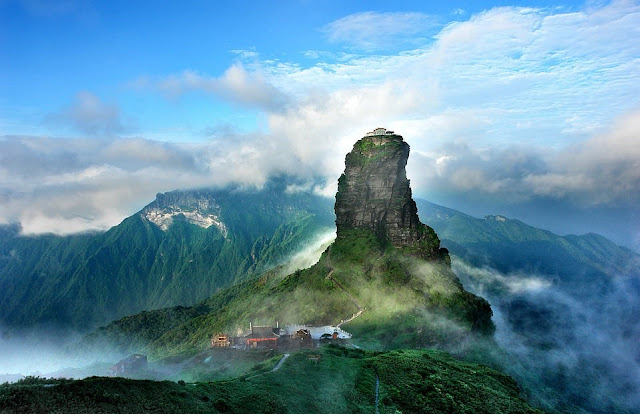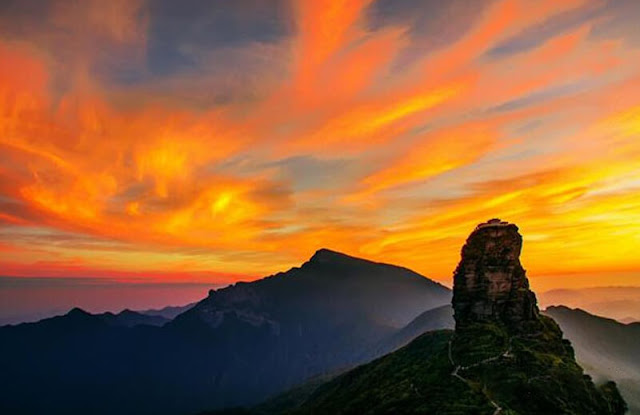梵淨山紅雲金頂(新金頂)
The Fanjingshan (梵净山: Fànjìngshān) or Mount Fanjing, located in 銅仁市, 貴州省Guizhou province, is the highest peak of the Wuling Mountains in southwestern China, at an elevation of 2,570 m (8,430 ft). Its name "Fanjing" is an abbreviation of Fantian Jingtu (梵天净土), or "Brahma's Pure Land". 梵天, Fantian is the Chinese name for the Buddhist heavenly king Brahmā, & 净土 Jingtu is Chinese for "pure land", the focus of Pure Land Buddhism.
梵净山, Fanjingshan, is located in 銅仁市Tongren, 貴州 Guizhou Province in southwest China. It is the highest peak of the Wuling Mountains. The elevation of its terrain ranges from 480 to 2,570 meters (1,570–8,430 ft) above sea level.
貴州省銅仁市梵淨山旅遊區 the Fanjingshan National Nature Reserve was established in 1978 and designated a UNESCO Biosphere Reserve in 1986 貴州省銅仁市江口縣梵淨山村. The reserve covers a total area of 567 km2 (219 sq mi) and is a conservation area for primitive vegetation of the mid-sub-tropic alpine region of western China. The mountain was designated a World Heritage Site in July 2018.
Fanjingshan's relative isolation has ensured a high degree of biodiversity. Endemic species such as the rare Guizhou golden monkey (Rhinopithecus brelichi) and the Fanjingshan fir (Abies fanjingshanensis) occur only in a small region centring on Fanjingshan. Several endangered species, including the Chinese giant salamander, forest musk deer, and Reeve's pheasant are also found in Fanjingshan. It is also home to the largest and most contiguous subtropical primaeval beech forest.
Fanjingshan is considered a sacred mountain of Chinese Buddhism, ranking just below the Four Sacred Mountains of Buddhism. It is considered बोधिमंड, the bodhimaṇḍa (or 道場: dàochǎng, meaning the "position of awakening")—a spot in which one reached enlightenment—of मैत्रेय बुद्ध, 彌勒佛, the Maitreya Buddha. The influence of Buddhism reached Fanjingshan by the Tang dynasty at the latest, especially after Hou Hongren (侯弘仁) constructed the Zangke Road (牂牁道) in 639 AD, which facilitated transport in the mountainous region, and local gazettes record the construction of several temples in the area. More temples were built during the ensuing Song and Yuan dynasties.
Buddhism greatly prospered during the Ming and Qing dynasties, when the cult of Tianguan Maitreya (天冠弥勒, 天冠彌勒) became dominant in Fanjingshan. 播州之役, the Bozhou rebellion, a Miao uprising that occurred in Guizhou and spread to 四川省Sìchuān shěng and 湖廣 Húguǎng between 1589 and 1600 during 大明 (明朝) the Ming dynasty in the late 16th century, caused great damages to Fanjingshan's temples. After suppressing the rebellion, 萬曆帝: Wànlì Dì, the Wanli Emperor ordered the monk Miaoxuan (妙玄) to rebuild the Golden Peak and the Cheng'en Temple (承恩寺). Many other temples were constructed in the area, ushering in the golden era for Buddhism in Fanjingshan. Most temples during the Ming and Qing dynasties belonged to the Pure Land and the Linji sects of Buddhism.
In the turmoil that toppled the Qing dynasty, many temples were destroyed by marauding armies and bandits, and few monks remained in the Republic of China era. After further destructions during the Cultural Revolution, Buddhism has enjoyed a renaissance since the 1980s. Many old temples have been rebuilt and new ones constructed, including the Cheng'en Temple, Huguo Chan Temple (护国禅寺, 護國禪寺), Great Golden Buddha Temple (大金佛寺), and Longquan Temple (龙泉寺, 龍泉寺).
In 2010, 梵淨山佛教文化公園, the Fanjingshan Buddhist Cultural Park was opened, with a Golden Hall that houses a five-meter-tall statue of मैत्रेय बुद्ध, 彌勒佛, the Maitreya Buddha made of 250 kilograms (550 lb) of gold and thousands of gems. It is said to be the largest gold Maitreya statue in the world.
Red Clouds Golden Summit (紅雲金頂 Hongyun Jinding)
紅雲金頂, Red cloud golden summit at night
The Thumb-like peak is described by UNESCO as an "island of metamorphic rock in a sea of karst", believed to have been formed somewhere between 2 million and 65 million years ago. For everyone else, one of the main appeals of visiting 梵淨山 Fanjingshan is the stunning views from the summit. Or rather, summits 一 there are three up there. The Red Clouds Golden Summit is the representative one, about 2336 meters above sea level. The whole crest is upright like a thumb as if the hill's encouragement for all the ambitious hikers. There is a steep vertical ascent of 100 meters to the top with a marvellous bridge connecting two Buddhist temples on each peak, which is known as the Fanjingshan Temple. During sunset/sunrise, the whole summit is enveloped with overhead red-tinted clouds, and Red Cloud, Hongyun in Chinese also means Good Luck (Hongyundangtou 鴻運當頭), and the summit was named after it.
बोधिमाता a bodhimaṇḍa is not synonymous with a बोधिमाला bodhimaṇḍala, which is a "circle of enlightenment".
मञ्जुश्री Mañjuśrī is धिसत्व, a bodhisattva associated with प्रज्ञा (pali : paññā: 般若, bōrĕ/bānruò) prajñā (wisdom) in महाज्ञान Mahāyāna बौद्ध धर्म Buddhism. His name means "Gentle Glory" in Sanskrit.
मञ्जुश्री Mañjuśrī is also known by the fuller name of मन्जुतारिकुमब्रह्म Mañjuśrīkumārabhūta,文殊师利菩薩, literally "Mañjuśrī, Still a Youth" or, less literally, "Prince Mañjuśrī". Another deity by the name of मञ्जुश्री Mañjuśrī is Mañjughoṣa.









No comments:
Post a Comment